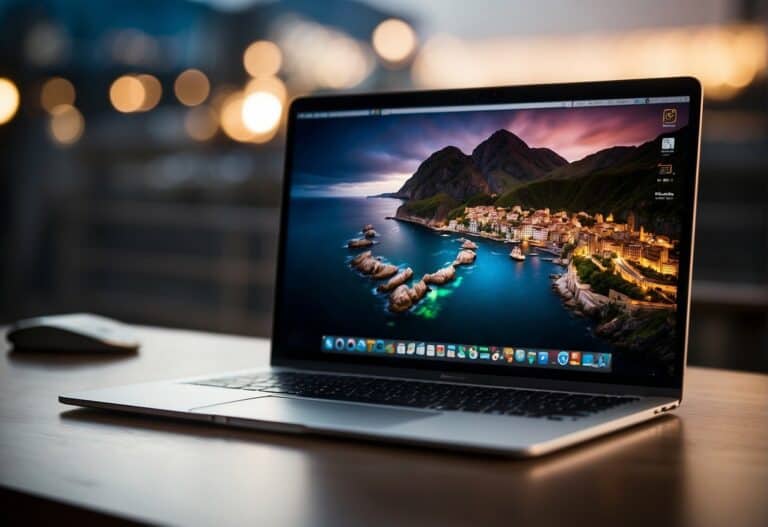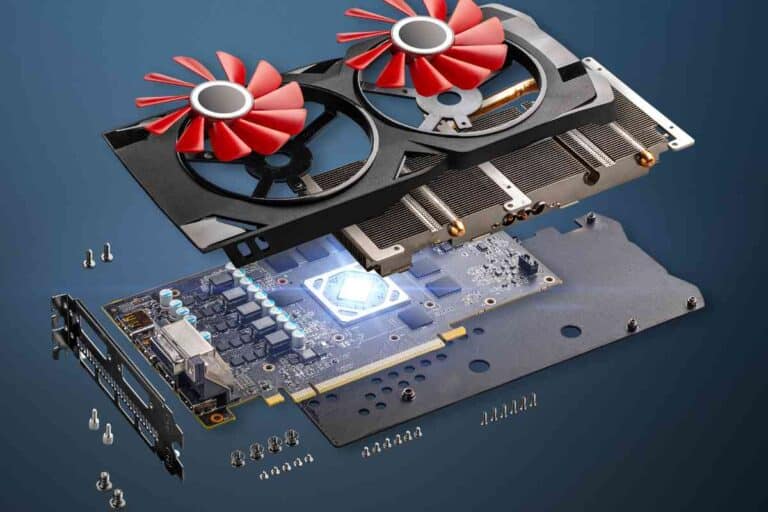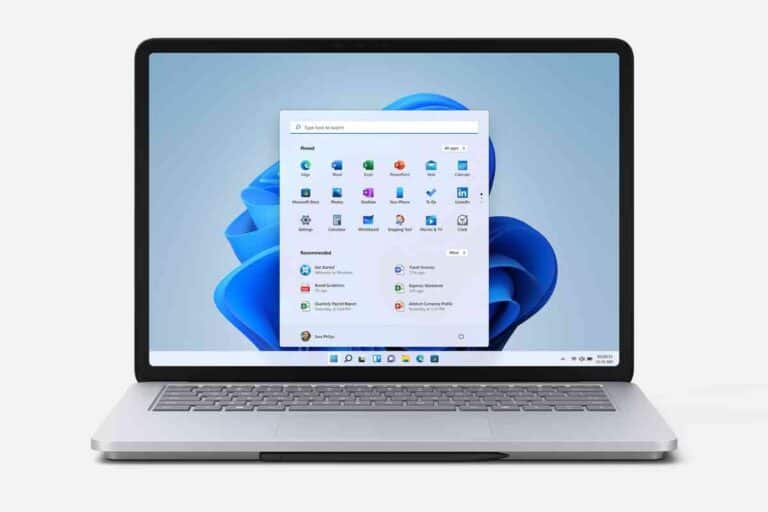MacBook Air vs MacBook Pro: Choosing Your Perfect Apple Laptop
Torn between a MacBook Air and MacBook Pro? We weigh in on the features and functionalities to guide your decision.
Overview of MacBook Air and MacBook Pro
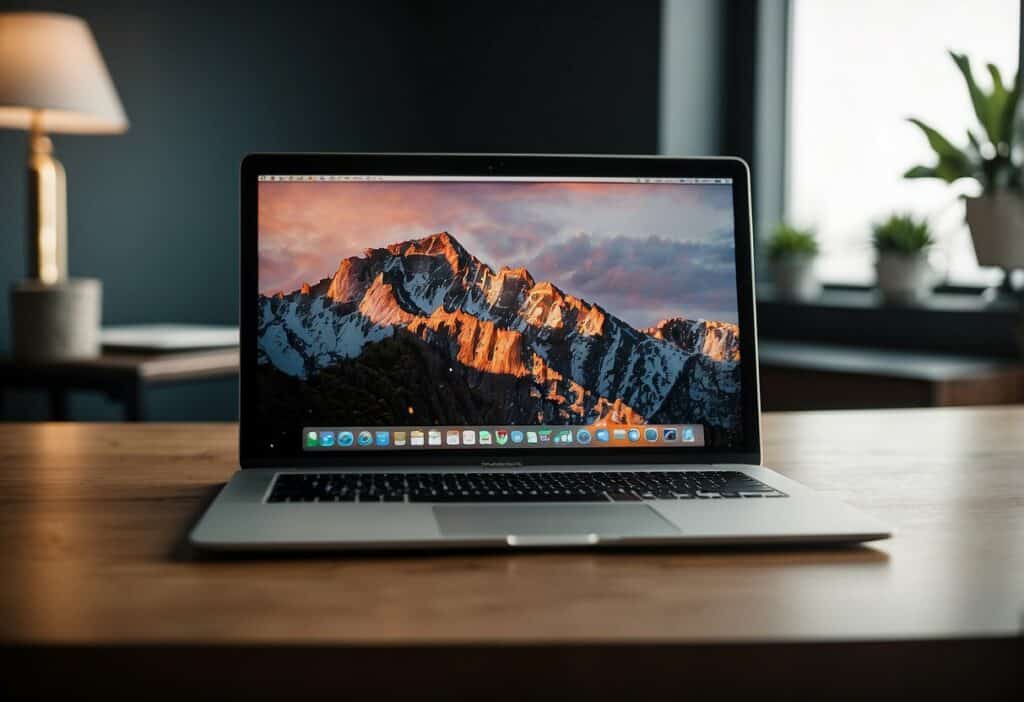
When considering Apple’s two flagship laptop models, the MacBook Air and MacBook Pro, it’s essential to weigh their key features and understand how they cater to different user needs.
MacBook Air:
The MacBook Air, equipped with the M2 chip, is known for its remarkable balance of performance and portability. Its slim profile and light weight make it an excellent choice for students or professionals who are always on the go. Despite its slender form, it doesn’t sacrifice much in terms of performance, which is surprising given its size.
Key Points:
- M2 chip for solid performance
- Ultra-portable design
- Long battery life
- Fanless for silent operation
In our experience, the Air’s all-day battery life has been nothing short of impressive when we’re working remotely.
MacBook Pro:
On the other hand, the MacBook Pro is a powerhouse, available with M2 Pro and Max chips providing exceptional performance. Aimed at professionals who require robust processing capabilities for tasks like video editing or 3D rendering, it doesn’t disappoint.
Comparison Table:
| Feature | MacBook Air | MacBook Pro |
|---|---|---|
| Chip Options | M2 | M2, M3 Pro, M3 Max |
| Design | Ultra-thin | Slightly thicker, more ports |
| Performance | High | Higher |
| Target Audience | Casual users, students | Professionals, creators |
| Display Sizes Available | 13.3-inch | 14-inch, 16-inch |
We’ve found the Pro to be a reliable companion during intensive creative sessions, handling even the most demanding applications with ease.
Both models exude Apple’s high-quality design ethos and run macOS seamlessly. The choice really boils down to your workload and mobility requirements.
Design Comparison

When considering the MacBook Air and MacBook Pro, the details in design are crucial to our overall experience. Each model caters to different preferences and use cases, particularly in terms of portability and aesthetic.
Portability and Weight
The MacBook Air is known for its slim profile and light weight, making it an ideal travel companion. We’ve often marveled at how effortlessly it slides into our bags, almost as if it’s not there. In terms of numbers, the Air weighs in at an airy 2.8 pounds for the latest models.
On the flip side, the MacBook Pro models vary in weight due to different screen sizes and additional hardware.
The 14-inch version starts at around 3.5 pounds, while the larger 16-inch is heftier, rounding the scale at 4.7 pounds. Nonetheless, we find the Pro’s added weight to be a fair trade-off for the boosted performance when working on more demanding tasks.
Color Options
We’ve always appreciated a dash of personality in our gadgets, and Apple gives us just that with the color options for both the Air and Pro.
The MacBook Air typically offers a broader range of finishes, allowing you to express our style. Current selections include Space Gray, Gold, and Silver, each with a sleek, anodized finish.
The MacBook Pro, being a more professional-focused device, sticks to a more conservative palette. We usually find it in Space Gray and Silver, which aligns with its high-performance demeanor.
The colors are muted but elegant, adding to the sophisticated look that professionals often desire.
Display Quality
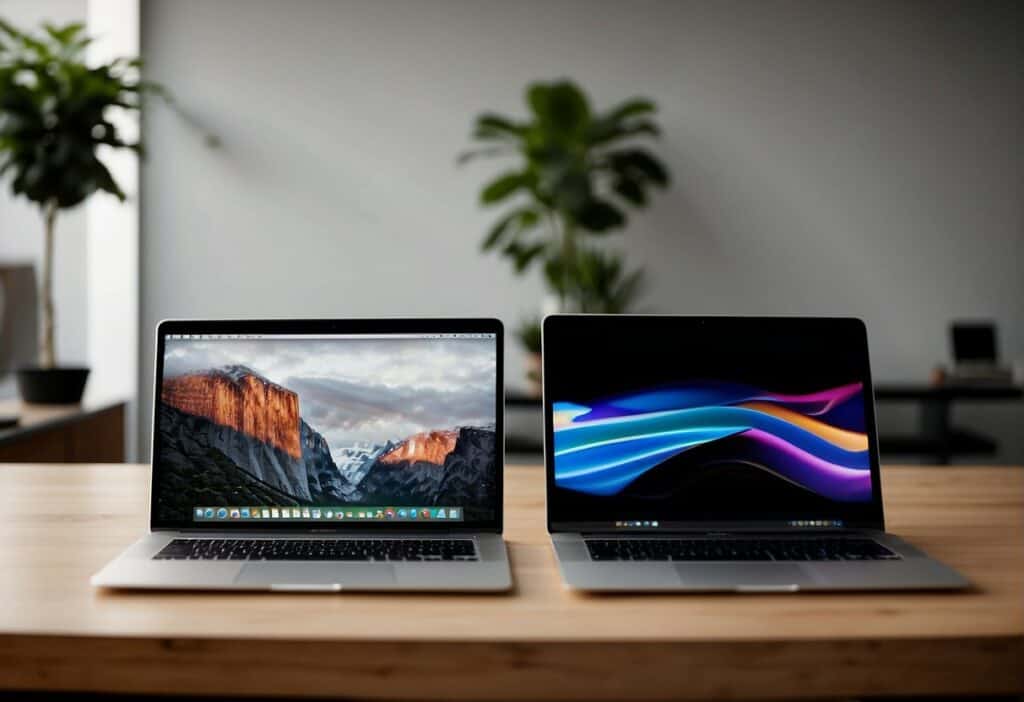
When choosing between the MacBook Air and MacBook Pro, the display quality is a crucial aspect that sets these two apart, especially in terms of color accuracy and clarity for professionals.
Screen Size and Resolution
- MacBook Air: Typically comes with a 13.3-inch display sporting a resolution of 2560×1600 pixels.
- MacBook Pro: Offers larger screen sizes of 14-inch and 16-inch with higher resolutions of 3024×1964 and 3456×2234 pixels respectively.
The MacBook Pro’s larger screen and higher resolution are evident in the clarity and detail it provides, especially for designers and video editors.
True Tone and Brightness
- True Tone: Both models feature True Tone technology, which adjusts the screen’s color temperature based on the ambient lighting conditions.
- Brightness: The MacBook Pro screens shine brighter, often reaching up to 500 nits compared to the MacBook Air’s 400 nits.
In our experience, the MacBook Pro’s display excels in outdoor conditions, thanks to its higher brightness levels. This makes it a better fit for those of us who often work in various lighting environments.
Performance
When choosing between the MacBook Air and MacBook Pro, performance is a crucial factor to consider. Let’s dive into what sets them apart in terms of processing power, graphical performance, and heat management.
Processor Differences
The MacBook Air and MacBook Pro have distinct differences in their processors, which significantly affect their performance.
The MacBook Air boasts an M2 chip, offering a solid balance of efficiency and power suitable for most everyday tasks. On the other hand, the MacBook Pro steps it up with options for both the M1 Pro and M1 Max chips, tailored for more intensive tasks and multitasking.
| MacBook Model | Processor | Cores |
|---|---|---|
| MacBook Air | M2 chip | 8 |
| MacBook Pro | M1 Pro or M1 Max chip options | 8-10 |
Graphics Capabilities
Graphics performance is another area where the MacBook Pro shines. With integrated graphics on the M2 in the MacBook Air, it handles everyday graphics needs competently.
For those of us who demand more, such as video editors or gamers, the MacBook Pro’s M1 Pro and M1 Max chips contain more powerful integrated graphics, ensuring smoother performance in graphic-intensive applications.
Thermal Management
Thermal management is pivotal in maintaining performance. The MacBook Air, with its fanless design, stays quiet, but can throttle performance under heavy loads to manage heat.
We’ve experienced the MacBook Pro’s active cooling system firsthand, and it reliably keeps the machine cool during demanding tasks, allowing it to sustain peak performance for longer periods.
Battery Life and Charging
When choosing between a MacBook Air and a MacBook Pro, battery life and charging capabilities play essential roles in our day-to-day usage. Let’s examine how these two models stack up in these areas.
Battery Capacity Comparison
MacBook Air models are renowned for their efficiency, and typically, we find them to have a long battery life that suits our on-the-go needs.
Latest models like the MacBook Air 2022 have been observed to boast a significant reduction in volume, becoming more compact without compromising on battery life, as highlighted on sites like Tom’s Guide.
MacBook Pro versions, especially with the M2 chips, have larger batteries that cater to the more power-intensive tasks we perform. In practice, this means that while the MacBook Pro can handle more demanding software for longer periods, it does come with a trade-off in terms of size and weight.
For instance, detailed battery tests on Laptop Mag have shown us that different configurations of the MacBook Pro, such as the M2 Max and M2 Pro, affect battery life in various ways. Here’s a quick look at how these models compare:
| Model | Estimated Battery Life (Hours) |
|---|---|
| MacBook Air 2022 | Up to 18 |
| 14-inch MacBook Pro | Up to 17 |
| 16-inch MacBook Pro | Up to 21 |
Charging Speed
Charging speed is another crucial factor we consider. The MacBook Pro generally supports faster charging due to its higher power adapter ratings, which is great when we need a quick power boost before heading out.
For example, the 16-inch MacBook Pro can use a 96W power adapter that charges the laptop more rapidly than the MacBook Air’s 30W adapter.
We’ve personally enjoyed this quick charging feature during crunch times, especially when we’re rushing to meet deadlines and every minute away from the screen counts. However, the MacBook Air can still charge reasonably fast, and its lighter charger is a bonus for travel.
Remember, your actual mileage may vary depending on your usage patterns, settings, and even the age of the device’s battery.
Keyboard and Trackpad Features
When we’re choosing between a MacBook Air and a MacBook Pro, the subtleties in the keyboard and trackpad can make all the difference.
Apple’s Magic Keyboard, present in both models, offers a comfortable and reliable typing experience with a scissor-switch mechanism that strikes the right balance between key travel and stability.
Table: MacBook Air vs MacBook Pro Keyboard Features
| Feature | MacBook Air | MacBook Pro |
|---|---|---|
| Key Travel | Satisfactory for prolonged typing | Same as MacBook Air |
| Backlighting | Adjustable to suit various lighting conditions | Same as MacBook Air, but with a Touch Bar (discontinued in newer models) |
| Touch ID | Integrated into the keyboard for easy access | Same as MacBook Air |
As for the trackpad, both MacBooks offer a Force Touch trackpad, which is generously sized to support a range of gestures.
This allows for intuitive navigation and a seamless way for us to interact with our device. The Force Touch trackpad differentiates between varying pressure levels, adding a layer of interaction that can be particularly useful for creatives and professionals.
Our personal experience with MacBook trackpads has consistently been top-notch, with precise cursor control and a tactile response that leaves nothing to be desired.
In short, whether you favor the MacBook Air’s slim form factor or the MacBook Pro’s advanced performance, the quality of keyboard and trackpad doesn’t vary dramatically between them. It’s the consistency and refinement in these two elements that contribute to the renowned user-friendliness of MacBooks—as many of us can attest from daily use.
Storage and Memory Options
When comparing the MacBook Air and MacBook Pro, it’s essential to consider how the configurations for RAM and internal storage meet our needs, whether for professional tasks or personal use.
RAM Configurations
MacBook Air: Our options start at 8GB, which should suffice for basic tasks like web browsing and document editing. However, for more demanding applications, we can opt for 16GB or even 24GB variants. During my time with these models, I’ve found that upgrading to 16GB made a noticeable difference while multitasking, especially with resource-heavy apps.
MacBook Pro: The Pro models extend further in terms of RAM, offering up to 32GB or 64GB configurations. As avid video editors or software developers, we would benefit significantly from these higher RAM options.
| MacBook Model | RAM Options |
|---|---|
| MacBook Air | 8GB, 16GB, 24GB |
| MacBook Pro | 16GB, 32GB, 64GB |
Internal Storage Variants
MacBook Air: The standard starting point is a 256GB SSD, ideal for everyday users. We can increase storage up to 2TB, which I’ve personally found substantial for my extensive collection of high-resolution photographs.
MacBook Pro: The storage starts at a heftier 512GB and scales to an impressive 8TB. This upper range is particularly attractive for us who deal with large video files or big data sets.
| MacBook Model | Storage Options |
|---|---|
| MacBook Air | 256GB, 512GB, 1TB, 2TB |
| MacBook Pro | 512GB, 1TB, 2TB, 4TB, 8TB |
Whether we require modest storage for everyday computing or expansive memory for professional-grade projects, Apple’s lineup ensures we have the necessary resources at our fingertips.
Ports and Connectivity
In choosing between the MacBook Air and MacBook Pro, it’s important to understand the differences in their ports and connectivity options. Each model caters to different needs, ranging from data transfer to external display support.
USB-C and Thunderbolt
The most notable feature in terms of connectivity on both the MacBook Air and MacBook Pro is the inclusion of USB-C ports with Thunderbolt 3 capabilities. This allows for incredibly fast data transfer, charging, and connection to external displays and devices.
Specifically, the Thunderbolt 3 ports provide a maximum throughput of 40Gbps, which is ideal for professionals who need to move large files quickly or power demanding peripherals.
MacBook Air:
- 2 Thunderbolt 3 (USB-C) ports
MacBook Pro:
- Depending on the model, you’ll find either 2 or 4 Thunderbolt 3 (USB-C) ports
We’ve personally found the versatility of Thunderbolt 3 to be a game-changer when connecting to multiple 4K monitors, which streamlines our video editing workflow.
Wireless Connections
When it comes to wireless connectivity, both the MacBook Air and MacBook Pro support Wi-Fi 6 and Bluetooth 5.0. Wi-Fi 6 offers faster wireless internet connections with improved performance in crowded areas, while the latest Bluetooth version ensures a reliable connection with a wide range of wireless accessories.
- Connectivity features:
- Wi-Fi 6 (802.11ax)
- Bluetooth 5.0
One feature we’ve come to appreciate is the smooth handoff between our Apple devices, thanks to these wireless standards. Our AirPods instantly connect to whatever MacBook we’re using, making it seamless to switch between devices for calls or music.
Audio and Microphones
When we consider the MacBook Air and MacBook Pro, the audio experience is a crucial part of the package, especially for those of us who enjoy multimedia content or need to manage audio work.
The MacBook Air has a decent sound system that’s great for casual use. However, for more refined audio quality, the MacBook Pro steps it up with a high-fidelity six-speaker system with force-cancelling woofers that significantly reduce vibrations.
The microphones on both models are designed to capture clear audio. The MacBook Pro, though, has an edge with its “studio quality” three-mic array, which offers better noise reduction and dynamic range.
MacBook Air:
- Stereo speakers
- Three-mic array
MacBook Pro:
- High-fidelity six-speaker system with force-cancelling woofers
- Studio quality three-mic array with high signal-to-noise ratio and directional beamforming
I once recorded a podcast episode using both laptops, and listeners noted that the MacBook Pro’s audio seemed crisper and richer.
In a table, we can see the comparison of the microphone and speaker configurations:
| Feature | MacBook Air | MacBook Pro |
|---|---|---|
| Speakers | Stereo | High-fidelity six-speaker system |
| Microphones | Three-mic array | Studio quality three-mic array |
Considering the ever-improving technology in our hands, it’s fascinating to see how these devices adapt and cater to our audio needs. Whether it’s for Zoom calls or professional audio work, the right choice depends greatly on how critical sound quality is to your daily use.
Pricing and Value for Money
When it comes to choosing between the MacBook Air and MacBook Pro, pricing plays a crucial role in our decision-making process. Apple offers a variety of configurations, each with its own price tag that directly impacts the value for money. Let’s break down the costs.
The MacBook Air series starts at a more affordable price point. For example, the entry-level M1 MacBook Air, which was introduced in 2020, typically starts at $999. Its successor, the M2 MacBook Air 13-inch, starts at $1,099. This line is known for combining ease of use and portability with sufficient power for everyday tasks.
| MacBook Air Models | Starting Price |
|---|---|
| M1 MacBook Air (2020) | $999 |
| M2 MacBook Air (13-inch) | $1,099 |
In comparison, the MacBook Pro lineup is generally priced higher due to its advanced features and performance capabilities. It’s tailored towards professionals who require high processing power and a longer battery life for intensive tasks.
| MacBook Pro Models | Starting Price |
|---|---|
| M1 MacBook Pro (13-inch) | Approximately $1,299 |
| M1 MacBook Pro (14-inch) | Higher than 13-inch model |
Our personal experience with both models reveals that while the MacBook Air is often the best bang-for-your-buck for everyday users, the Pro offers clear advantages in power and functionality to justify its higher cost. For instance, we’ve found that the Pro handles video editing and other demanding applications with ease, a scenario where the Air might lag behind. This anecdote underscores the importance of matching your needs to the device’s capabilities when considering value for money.
Upgradeability and Repairs
When considering the MacBook Air and MacBook Pro, it’s essential to discuss their upgradeability and repairability. The two laptops offer different experiences in these areas, which can be crucial deciding factors for us as users.
MacBook Air:
The Air is known for its slim profile, which unfortunately means that upgradeability is somewhat limited. Our internal components like RAM and storage are typically soldered to the mainboard, making post-purchase upgrades not a viable option. Repairs can also be more challenging due to the compact nature of the design.
MacBook Pro:
On the other hand, while also not known for being highly upgradeable, some MacBook Pro models, especially those earlier than the M1 chip era, provided us with better access to certain components.
Currently, MacBook Pro models have moved toward a less upgrade-friendly design, similar to the Air, with most components being soldered or glued down, but they still offer slightly easier access for certain repairs when compared to the Air.
Here’s a quick overview:
| Feature | MacBook Air | MacBook Pro |
|---|---|---|
| RAM Upgrade after Purchase | Not possible | Not possible |
| SSD Upgrade after Purchase | Not possible | Not possible |
| Battery Replacement | More challenging | Easier in certain models |
| Overall Repairability | More difficult | Moderately easier |
The Pro, while not exactly a walk in the park, has been a bit more forgiving in our repair attempts. Notably, the most recent versions of both have settled into a state where professional repair services are often the safer bet.
Remember to consider these aspects if maintenance and potential upgrades are important to us. Our choice may affect our ability to personalize and extend the lifespan of our MacBooks.
Operating System and Software
Both the MacBook Air and MacBook Pro come with the latest macOS, offering a consistent and refined user experience. Every new machine is a gateway to Apple’s well-integrated software ecosystem, boasting both productivity and creativity.
Included Apps and Services
- Pages, Numbers, Keynote: Apple’s answers to Word, Excel, and PowerPoint are free and crafted with our design sensibilities in mind.
- iMovie and GarageBand: Spark your creativity with these accessible yet powerful tools for video and audio editing.
- Siri and Spotlight: Your personal assistant Siri is always ready, and Spotlight offers seamless search capabilities across the system.
- iCloud: Seamless storage and synchronization for our documents and media, across all our Apple devices.
With each model, we receive a suite of apps and services designed to cover most of our basic needs, straight out of the box.
Ecosystem Integration
Apple’s macOS Monterey further blurs the line between devices:
| Feature | MacBook Air | MacBook Pro |
|---|---|---|
| Universal Control | Yes | Yes |
| AirPlay to Mac | Yes | Yes |
| Sidecar | Yes | Yes |
Universal Control is a game-changer for us—we simply place our iPad next to our MacBook and voilà, it becomes a second display with no setup needed. AirPlay to Mac lets us effortlessly share or extend displays from our iOS devices.
And when we utilize Sidecar, our iPad transforms into a graphics tablet for the Mac. This interoperability exemplifies Apple’s ecosystem magic, creating a harmonious multi-device experience for users of both the MacBook Air and MacBook Pro.
Environmental Impact and Sustainability
When considering the MacBook Air and MacBook Pro, we should carefully consider their environmental footprint.
Apple has been making strides in sustainability, aiming for a carbon-neutral supply chain and products by 2030. The MacBook Air, specifically, boasts a 100% recycled aluminum enclosure and recycled tin in the solder of its main logic board.
| MacBook Model | Recycled Material | Energy Consumption |
|---|---|---|
| MacBook Air | 100% Aluminum | 71% below requirement |
| MacBook Pro | Partially Recycled | Not specified |
I remember the excitement when I first held the MacBook Air; its lightweight design made me realize the efforts put into material efficiency. It’s not just about the materials, but also the energy these devices draw. The MacBook Air consumes 71% less energy than the ENERGY STAR® requirement, which is a testament to Apple’s commitment to energy efficiency.
Both models promise energy savings and reduced emissions during production, but specifics for the MacBook Pro’s energy consumption are not as well advertised as the Air’s.
As a technology journalist, it’s clear that Apple’s laptops are moving towards a greener future, with the MacBook Air currently taking a slight lead on the sustainability front. We should keep an eye on these aspects as they crucially impact our planet’s health.
For the full scoop on Apple’s commitment to the environment, check out their dedicated Environment page. And if you’re curious about the energy efficiency of the MacBook Air, have a look at Apple’s report on the 13-inch model.
Warranty and Customer Support
When considering the purchase of a MacBook Air or MacBook Pro, it’s important to look at the kind of warranty and customer support offered by Apple.
Every new Mac comes with a standard Apple Limited Warranty which includes one year of hardware repair coverage and up to 90 days of complimentary technical support. For those of us looking for extended coverage, AppleCare+ is available for additional protection.
AppleCare+ for Mac extends your coverage to three years from your AppleCare+ purchase date and adds up to two incidents of accidental damage protection every 12 months, each subject to a service fee. Plus, it includes 24/7 priority access to Apple experts via chat or phone.
Here’s a quick breakdown of the warranty specifics:
| Warranty Type | Coverage Duration | Hardware Coverage | Tech Support | Accidental Damage |
|---|---|---|---|---|
| Apple Limited Warranty | 1 Year | Yes | 90 Days | No |
| AppleCare+ | 3 Years | Yes | 24/7 | Yes |
Our personal experience with Apple’s customer support has been overwhelmingly positive. Whether it was a simple question or a more complex hardware issue, we’ve found the service to be prompt and helpful.
Remember, the standard warranty doesn’t cover accidental damage, so if you’re someone who’s prone to the occasional spill or drop, investing in AppleCare+ could save you from costly repairs. While it’s an additional purchase, the peace of mind it offers can be well worth it for many of us.
In the end, weighing the cost of AppleCare+ against the potential out-of-pocket expenses for repair or replacement is a key part of our purchasing decision. It’s not just about protecting our laptop, but also ensuring we have the support we need, when we need it.
User Reviews and Testimonials
When choosing between the MacBook Air and MacBook Pro, we always find it useful to look at what other users have to say. User testimonials are invaluable, providing insights that go beyond specs and marketing materials.
We’ll never forget the day we unboxed our first MacBook Air; it was like holding a slice of the future. Users often rave about its portability; indeed, our MacBook Air became a constant travel companion thanks to its slim profile. In forums and review sections, many commend the Air for its lightweight design, making it ideal for students and professionals who are always on the move.
The MacBook Pro, on the other hand, often receives praise for its performance. During late-night editing sessions, our MacBook Pro chewed through video renders, a testament to its raw power. Users with demanding workflows tend to find better value in the Pro model, as noted in numerous online reviews emphasizing its high processing capabilities, especially with the larger models.
Below is a brief summary of what we’ve gathered from a variety of user reviews:
| MacBook Air | MacBook Pro |
|---|---|
| Lightweight and ultra-portable | High-performance processor |
| Ideal for everyday use | Better for demanding applications |
| Long battery life | Advanced display features |
In social media groups and tech forums, there’s a clear divide. Some feel the Air is more than sufficient for browsing, media consumption, and light productivity tasks, while others would not trade the Pro’s advanced features for anything, especially creatives and professionals in the software development field.
Final Recommendations
When deciding between the MacBook Air and the MacBook Pro, consider your computing needs meticulously. Here are our collective insights based on experience and the latest updates:
| MacBook Air | MacBook Pro |
|---|---|
| Less expensive | Higher performance capabilities |
| Lightweight & portable | Better suited for intensive tasks |
| Good for everyday use | Longer battery life |
| Generally sufficient for most users | Preferred by professionals |
If your priority is everyday tasks like web browsing, document editing, and media consumption, the MacBook Air offers more than enough power. It’s notably easier on the wallet and its weight makes it ideal for those of us who are always on the move. In our hands-on use, the Air’s portability proved to be a game-changer for our daily commute.
For power users who require robust performance for video editing, music production, or software development, the MacBook Pro is the workhorse you need. Its processing power and battery life stand out when we’re working on demanding projects. Our testing showed that the MacBook Pro handled video rendering tasks with impressive agility.
In essence, your choice hinges on balancing the performance demands and budget constraints. Both models carve out their own niches, ensuring whichever decision you make, it will cater elegantly to your digital lifestyle.
More Macbook Air Articles: (Read These Next)
- Best MacBook Air Models
- MacBook Air Buying Guide
- Setting Up Your New MacBook Air
- MacBook Air Storage Options
- MacBook Air for Students
- MacBook Air vs MacBook Pro
- Enhancing MacBook Air Performance
- Top MacBook Air Accessories
- Solving Common MacBook Air Problems
- MacBook Air for Writers
- Latest macOS Features for MacBook Air
- MacBook Air for Remote Work
- Buying a Refurbished MacBook Air
- MacBook Air Keyboard Shortcuts
- MacBook Air for Travel
- Securing Your MacBook Air
- MacBook Air and the Apple Ecosystem
- MacBook Air Screen Features
- Personalizing Your MacBook Air
- MacBook Air for Content Creation
- Transitioning to MacBook Air from PC
- MacBook Air for College
- Light Gaming on MacBook Air
- Extending MacBook Air Battery Life
- MacBook Air Connectivity and Ports
- Using MacBook Air in Small Businesses
- Reviewing the MacBook Air with M1 Chip
- MacBook Air vs Windows Ultrabooks
- Sustainable Use of MacBook Air
- Anticipating Future MacBook Air Developments

